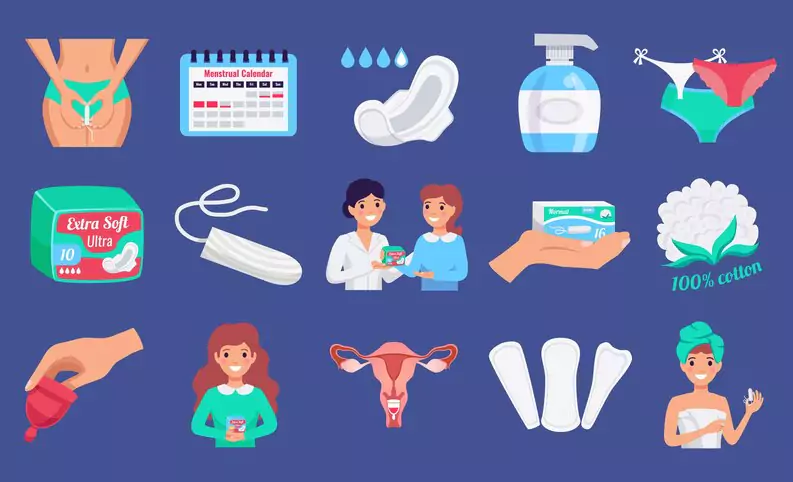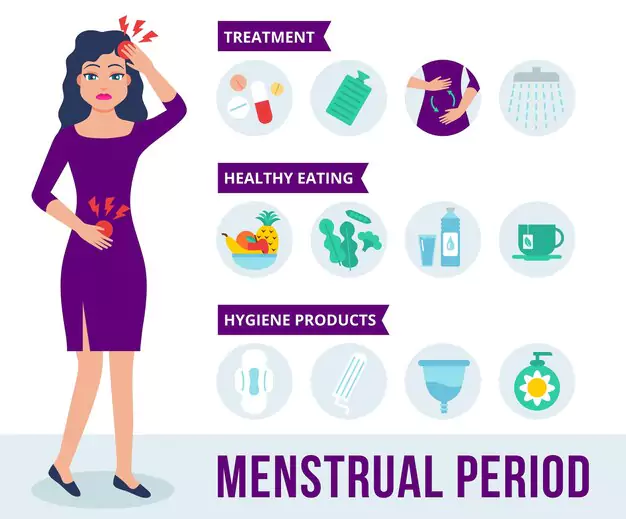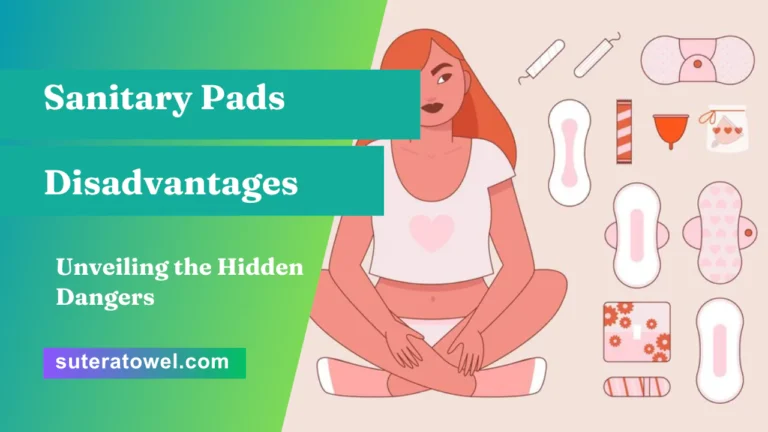Sanitary Pads Disadvantages such as causing skin irritation and discomfort during use. Sanitary pads are widely used by women all over the world as a convenient and easy-to-use menstrual hygiene product.
They come with their own set of advantages, but it is essential to be aware of their disadvantages as well. We will discuss some of the disadvantages of using sanitary pads. From skin irritation to discomfort during use, it is important to weigh the pros and cons before deciding whether or not to use sanitary pads.
By understanding the drawbacks, women can make informed choices regarding their menstrual hygiene and explore alternative options that may better suit their needs.
Understanding The Composition Of Sanitary Pads

Sanitary pads can have disadvantages when it comes to their composition. Understanding these drawbacks is essential for women seeking alternative menstrual products.
Sanitary pads are a common choice for menstrual hygiene management. However, it is essential to understand their composition to be informed about their potential disadvantages. Let’s delve into the components of sanitary pads and explore the potential harm they can pose to our health.
Harmful Chemical Additives In Sanitary Pads
- Fragrances: Many sanitary pads contain fragrances to mask unpleasant odors. However, these artificial scents can cause skin irritation and allergic reactions in some individuals.
- Dyes: The vibrant colors of sanitary pads may be appealing, but these dyes often contain harmful chemicals. Prolonged exposure to these chemicals may lead to skin irritation, itching, and discomfort.
- Chlorine and dioxins: These chemicals are used in the bleaching process of pad production. Chlorine can react with natural organic matter in the pads and produce dioxins, which are toxic and have been linked to various health issues, including hormone disruption.
Impact Of Synthetic Materials On Health
- Plastic components and backings: Sanitary pads often contain plastic components and backings to enhance leak protection. However, constant contact with plastic against the skin can hinder breathability and increase the risk of sweat accumulation and irritation.
- SAP (Super Absorbent Polymer): SAP is commonly used in pads to enhance absorbency. However, this synthetic material can potentially cause skin irritation and allergic reactions in certain individuals.
- Adhesive chemicals: To ensure pads stick to undergarments securely, adhesive chemicals are used. These chemicals can sometimes cause skin sensitivity issues, leading to redness, itching, and rashes.
By understanding the composition of sanitary pads, we become more aware of the potential drawbacks associated with their use. It is essential to make informed choices about menstrual hygiene products, considering alternatives that prioritize our overall health and well-being.
Health Risks Associated With Sanitary Pad Usage

Sanitary pad usage poses health risks, including irritation, infections, and allergic reactions due to chemicals used in their production. Additionally, prolonged and improper use of pads can lead to skin rashes and discomfort. Regularly changing pads and considering alternative menstrual products can help minimize these disadvantages.
Sanitary Pads Disadvantages
Sanitary pads have long been a popular choice for women when it comes to managing menstruation. However, it’s important to understand that there can be some health risks associated with their usage. In this section, we will explore the potential disadvantages of using sanitary pads, focusing specifically on allergic reactions and skin irritations, increased risk of infections, and disruption of vaginal pH balance.
Allergic Reactions And Skin Irritations
- Some women may experience allergic reactions to certain materials used in the production of sanitary pads, such as fragrances, dyes, or adhesives. These reactions can manifest as itchiness, redness, or rashes in the genital area.
- Skin irritations can also occur due to prolonged exposure to moisture and lack of breathability. This is especially common when pads with plastic backings are used, as they can trap heat and moisture against the skin.
Increased Risk Of Infections
- Sanitary pads, especially when not changed frequently enough, can create a warm and moist environment that promotes bacterial growth. This can increase the risk of developing infections, such as urinary tract infections (UTIs) or yeast infections.
- Prolonged use of pads can also lead to a condition called vulvovaginitis, which is an inflammation of the vulva and vagina caused by irritation or infection. This condition can result in discomfort, itching, and abnormal discharge.
Disruption Of Vaginal pH Balance
- The use of certain chemicals and fragrances in sanitary pads can disturb the natural pH balance of the vagina. Maintaining a healthy pH level is crucial for the prevention of infections and maintaining overall vaginal health.
- A PH imbalance can lead to an overgrowth of harmful bacteria, causing conditions like bacterial vaginosis (BV). BV is characterized by abnormal discharge, an unpleasant odor, and itching.
It’s important to note that while these health risks exist, not every woman will experience them. Each individual’s reaction to sanitary pads can vary. It’s always recommended to choose pads made from breathable materials, change them frequently, and consult a healthcare professional if any persistent discomfort or symptoms occur.
By being aware of these potential disadvantages, women can make informed decisions about their menstrual hygiene and explore alternative options if necessary.
Long-Term Effects Of Continuous Sanitary Pad Use

Continuous use of sanitary pads can have long-term effects on women’s health. Prolonged exposure to synthetic materials and chemicals in these pads may lead to skin irritation, allergies, and even reproductive issues. Regular breaks and exploring alternative menstrual products can help mitigate these disadvantages.
Sanitary Pads Disadvantages:
Sanitary pads are widely used by women around the world during menstruation for their convenience and ease of use. However, continuous use of sanitary pads over a long period of time can have certain drawbacks. This section will shed light on the potential long-term effects of continuous sanitary pad use, exploring its link to reproductive issues, association with hormonal imbalances, and environmental impact.
Potential Link To Reproductive Issues
- Chemical exposure: Sanitary pads often contain chemicals such as dioxins and synthetic fragrances, which may be harmful when exposed to the reproductive organs for an extended period.
- Prolonged contact: The prolonged use of sanitary pads can lead to prolonged exposure of the reproductive organs to moisture and synthetic materials, potentially increasing the risk of certain reproductive issues.
- Menstrual cup alternative: Considering the potential risks, some women opt for alternative menstrual products like menstrual cups to reduce their exposure to chemicals and potential reproductive issues.
Association With Hormonal Imbalances
- Endocrine disruptors: Sanitary pads may contain chemicals known as endocrine disruptors, which can interfere with the body’s hormonal balance.
- Estrogen dominance: Continuous use of sanitary pads may contribute to estrogen dominance, leading to hormonal imbalances that can result in various health issues.
- Natural alternatives: Women concerned about hormonal imbalances can explore natural alternatives like reusable cloth pads or period underwear, which do not contain chemicals and are more environmentally friendly.
Environmental Impact Of Disposable Sanitary Pads
- Landfill waste: Disposable sanitary pads contribute to the mounting problem of landfill waste due to their non-biodegradable nature.
- Plastic waste: Most disposable sanitary pads are made with a combination of plastic materials, further exacerbating the plastic waste problem.
- Sustainable alternatives: Choosing reusable alternatives like cloth pads or menstrual cups can significantly reduce the environmental impact of menstruation products and promote sustainability.
It is essential to be aware of the potential long-term effects of continuous sanitary pad use. Considering the potential link to reproductive issues, association with hormonal imbalances, and the environmental impact of disposable sanitary pads, women have various alternative options available to them.
Exploring natural and sustainable alternatives can ensure both menstrual hygiene and ecological responsibility.
Frequently Asked Questions On Sanitary Pads Disadvantages
Is It Healthier To Wear Pads?
Wearing pads can be healthier due to improved hygiene and reduced risk of infections.
What Are The Risks Of Wearing Pads?
Wearing pads can pose risks like skin irritation, allergies, discomfort, and a higher risk of infections.
What Are The Safest Sanitary Pads To Use?
The safest sanitary pads to use prioritize your health and comfort. Look for brands with organic materials and chemical-free options.
Are Sanitary Pads Harmful To The Environment?
Sanitary pads are made from non-biodegradable materials, such as plastic and synthetic fibers, leading to environmental concerns. When disposed of improperly, they can contribute to pollution and take hundreds of years to decompose. Using eco-friendly alternatives like organic pads or menstrual cups can be a more sustainable choice.
Conclusion
While sanitary pads are a popular choice for many women during their menstrual cycles, it is important to be aware of their disadvantages. Firstly, the use of plastic and non-biodegradable materials in most pads contributes to environmental pollution. Secondly, the chemicals used in the production of these pads can cause skin irritation and allergies.
Additionally, the lack of proper disposal options can lead to unhygienic conditions and health risks. Moreover, the high cost of sanitary pads can be a barrier for women in low-income communities, limiting their access to safe menstrual hygiene products. However, it is important to note that there are alternatives available, such as reusable menstrual cups or cloth pads, which address these concerns and provide a more sustainable and affordable option.
Ultimately, it is crucial to prioritize our health and the environment when choosing menstrual hygiene products.

